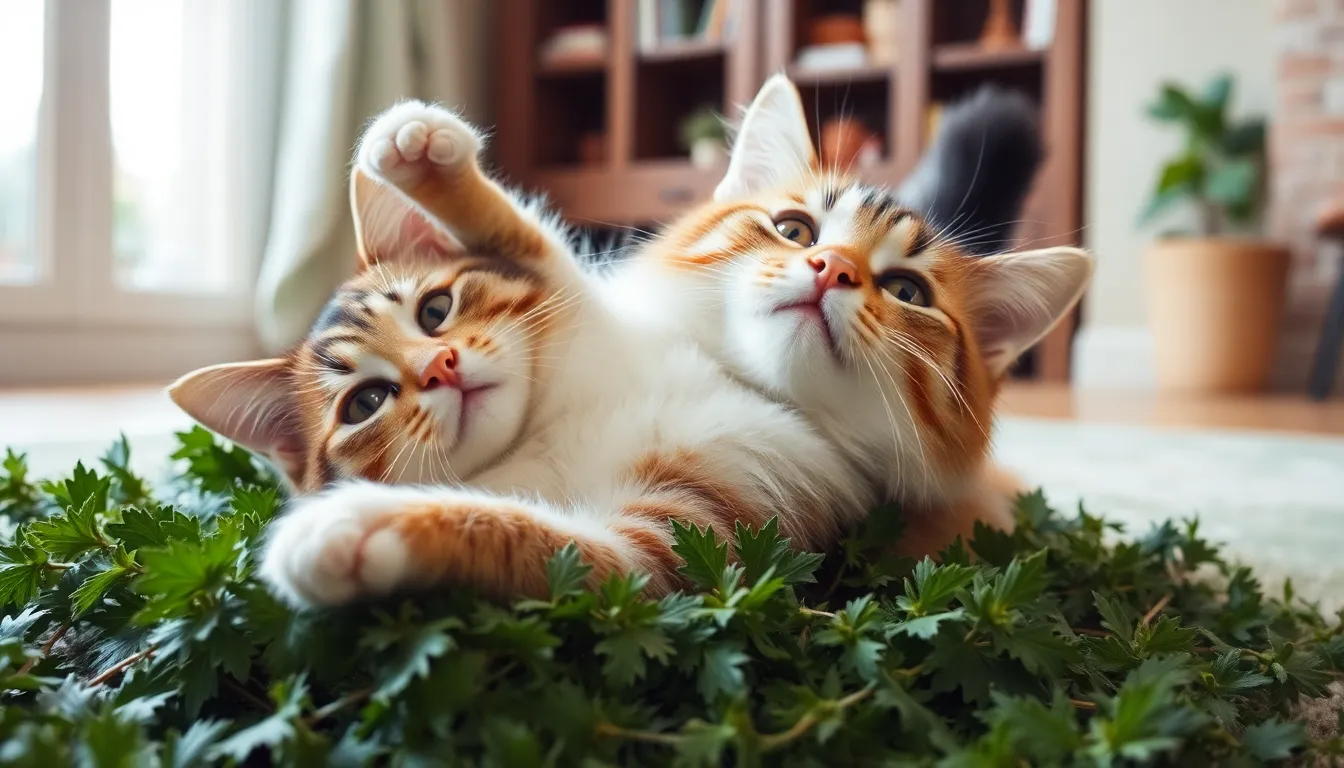When it comes to feline fun, few things ignite a cat’s spirit quite like catnip. This magical herb sends cats into a euphoric frenzy, making them roll, pounce, and act like they just discovered a hidden stash of catnip cookies. But what if this playful plant is more than just a harmless treat? Is catnip the feline equivalent of weed for cats?
Table of Contents
ToggleUnderstanding Catnip
Catnip, a member of the mint family, captivates many cats. This herb contains a compound called nepetalactone that engages feline senses.
What Is Catnip?
Catnip refers to Nepeta cataria, a perennial herb native to Europe and Asia. This plant features jagged leaves and small, white flowers, which attract various insects. In the presence of nepetalactone, many cats experience intensified excitement. This compound binds to receptors in a cat’s nasal tissue, triggering playful behavior. Dried catnip is often used in toys, while fresh catnip can be grown easily at home.
How Do Cats React to Catnip?
Cats typically respond to catnip with enthusiastic behavior. Common reactions include rolling, rubbing, and playful antics. About 50 to 75 percent of cats show sensitivity to this herb, with the effect lasting around 10 to 15 minutes. Some may exhibit a temporary state of calm after the initial excitement. Factors like age and genetics play a role in each cat’s response. Overall, reactions enhance the cat’s experience but do not cause any harm.
The Science Behind Catnip

Catnip affects cats through a unique chemical compound. It engages feline senses and induces playful reactions.
Nepetalactone: The Active Component
Nepetalactone, found in catnip leaves and stems, triggers responses in cats. This compound interacts with odor receptors, producing a euphoric effect. Studies indicate that up to 75 percent of cats respond to nepetalactone. Kittens and elderly cats show less sensitivity, while adult cats typically react strongly. Sensitivity often comes from genetics, and reactions can vary widely among individuals.
Effects on Cat Behavior
Catnip elicits various behavioral responses, including rolling, rubbing, and purring. Many cats experience heightened energy and playfulness. This stimulation lasts around 10 to 15 minutes, after which cats often return to a state of calm. Observers note that catnip may also reduce stress and anxiety in some felines. Repeated exposure decreases sensitivity temporarily, making it important to allow breaks between sessions.
Comparing Catnip and Cannabis
Both catnip and cannabis exhibit intriguing effects on their respective users. While catnip affects cats, cannabis affects humans.
Similarities Between Catnip and Weed
Both substances create euphoric feelings. Catnip contains nepetalactone, which engages cats’ sensory receptors, similar to how cannabinoids interact with humans’ endocannabinoid system. Playfulness often emerges in cats when exposed to catnip, akin to the relaxed state many experience with cannabis. Both can induce short-term effects; catnip reactions last around 10 to 15 minutes, while cannabis effects vary based on strain and dosage.
Differences Between Catnip and Weed
Catnip primarily targets felines; cats show sensitivity due to their unique biology. On the other hand, cannabis affects humans and can induce various effects, from relaxation to anxiety. Catnip poses no harmful risks, whereas cannabis can lead to health complications with misuse or overconsumption. Notably, a small percentage of cats, specifically 25 to 50 percent, exhibit no reaction to catnip, contrasting with the widespread effects of cannabis on humans.
Benefits of Catnip for Cats
Catnip offers multiple benefits for felines. Its playful effects contribute significantly to their overall well-being.
Enrichment and Play
Encouraging active play, catnip enhances mental stimulation. Cats engage in various behaviors, including rolling, rubbing, and jumping. These playful actions promote exercise and reduce boredom. By providing a source of joy, catnip appeals to both young and adult cats. Owners report that their pets display increased enthusiasm when catnip is introduced. Additionally, incorporating catnip into toys or scratching posts adds variety to their environment, keeping them engaged and alert.
Stress Relief and Relaxation
Offering calming effects, catnip helps alleviate stress in felines. When cats encounter catnip, they often experience a wave of relaxation after the initial excitement. This soothing transition can benefit situations that provoke anxiety, such as visits to the vet or changes in the household. The behavioral response to catnip, characterized by gentle purring and extended rest periods, indicates its efficacy in promoting tranquility. In this way, catnip not only entertains but also supports mental health for many cats.
Potential Risks and Considerations
Catnip is generally safe for cats, but certain risks exist that owners should consider.
Overexposure to Catnip
Overexposure to catnip can lead to reduced sensitivity in some felines. Frequent access may diminish its euphoric effects, meaning cats might not respond as enthusiastically over time. To maintain its allure, it’s wise to allow breaks between catnip sessions. A suggestion involves limiting exposure to once every week or two. This schedule helps preserve the plant’s potency for future interactions, ensuring that cats remain engaged and stimulated.
Myths About Catnip
Several myths about catnip can mislead pet owners. One common misconception states that catnip is addictive, when in fact, it’s non-addictive and safe to use. Some believe that all cats react to catnip, but studies show that around 25 to 50 percent of cats show no sensitivity. Another myth suggests that catnip will harm cats, which is inaccurate; in moderation, it contributes positively to a cat’s well-being. Dispelling these myths aids owners in understanding catnip while enhancing their pets’ experiences.
Catnip offers a unique experience for cats that can be likened to the effects of cannabis on humans. While both substances create euphoric feelings catnip is specifically designed for felines and poses no health risks. Its ability to stimulate playful behavior and reduce stress makes it a valuable addition to any cat’s environment.
Understanding the nuances of catnip usage can enhance the bond between cats and their owners. By providing catnip in moderation and allowing breaks between sessions pet owners can ensure their cats enjoy its benefits without diminishing sensitivity. Overall catnip serves as a delightful and safe way to enrich a cat’s life promoting both playfulness and relaxation.





